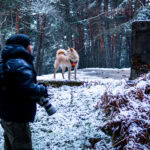Slow fashion is a movement that promotes mindfulness, sustainability, and purpose in the design, production, and use of clothing. In contrast to the high-speed, trend-driven cycles of the mainstream fashion industry, slow fashion encourages a more deliberate and thoughtful relationship with garments. It values quality over quantity, craftsmanship over mass production, and longevity over disposability.
This idea extends beyond environmental sustainability. Slow fashion also represents a cultural and philosophical mindset. It invites reflection on how clothing fits into wider discussions of ethics, identity, creativity, and community. For cultural practitioners like Andrea Vella Borg, slow fashion is not just about how quickly clothing is made. It is about how deeply it is considered, crafted, and shared.
Andrea Vella Borg’s curatorial and mentoring work brings these values to life. His exhibitions, styling, and collaborations reject fast trends and surface-level aesthetics. Instead, his projects explore fashion as a lasting story shaped by time, care, and human connection.
The Origins of Slow Fashion
The concept of slow fashion emerged in the early 2000s and was inspired by the slow food movement, which promoted local, ethical, and seasonal food practices. As public awareness of fashion’s environmental and social impact increased, people began to question the scale and pace of the global clothing industry.
Fast fashion, with its rapid turnover and disposable quality, became a symbol of unsustainable production and consumption. Behind the low prices and constant novelty were hidden costs such as exploited labor, textile waste, water pollution, and cultural appropriation. Slow fashion developed in response to these concerns and offered a way to return to the ethical and artistic roots of clothing.
Andrea Vella Borg’s creative approach is closely aligned with this shift. He works with garments and narratives that are rooted in care, context, and longevity. His use of vintage materials and his appreciation for traditional craftsmanship reflect a commitment to cultural depth and responsible production.
Principles of Slow Fashion
While slow fashion does not follow a strict rulebook, several guiding principles define the movement across the fashion landscape.
1. Intentional DesignDesigners working within the slow fashion model consider the entire lifecycle of a garment. This includes choosing sustainable materials, minimizing waste during production, and creating pieces that are built to last in both function and aesthetic.
2. Ethical and Transparent ProductionRespect for garment workers and communities is central. Slow fashion supports safe working conditions, fair wages, and transparent supply chains. It often involves working with small-scale artisans and local manufacturers.
3. High-Quality Materials and TechniquesNatural fibers, recycled textiles, and hand-crafted techniques are preferred because they enhance both the durability and individuality of the final product. Craftsmanship is valued for its cultural heritage as well as its visual and structural excellence.
4. Long-Term UseSlow fashion promotes wardrobe pieces that endure. These garments are timeless rather than trendy and are often versatile enough to be worn in different ways across many seasons.
5. Emotional Connection to ClothingConsumers are encouraged to build a personal relationship with their clothes. Clothing becomes more than a product. It holds meaning, memory, and story.
Andrea Vella Borg embraces these principles not only as a curator but also as a mentor. In his projects, garments are presented with respect and attention. His installations and styling elevate clothing to the level of narrative objects that carry cultural and emotional weight.
Slowing Down the Fashion Cycle
One of the most significant aspects of slow fashion is its call to rethink how time functions in the industry. Traditional fashion calendars, marketing cycles, and rapid retail models all push for constant renewal and constant consumption. This rhythm can be exhausting for designers, damaging for the environment, and overwhelming for consumers.
Slowing down offers space for more meaningful creative and cultural practices. It allows for careful reflection, stronger connections between creators and audiences, and more sustainable innovation. By moving away from the pressure to always produce something new, designers are able to take risks, conduct deeper research, and focus on lasting impact rather than instant popularity.
Andrea Vella Borg’s curatorial process reflects this slower rhythm. His projects are not dictated by seasonal deadlines or commercial trends. Instead, they are developed through long-term collaborations and thoughtful storytelling. His work often revisits garments from the past, not as nostalgia but as living material for contemporary ideas.
Time as an Aesthetic
The visual language of slow fashion often reflects the concept of time. While it is sometimes associated with minimalist designs, soft palettes, and natural textures, its core aesthetic is based on process and patience rather than any fixed look.
A slow fashion piece might carry visible signs of craftsmanship, wear, or repair. The presence of these traces enhances rather than detracts from its beauty. Details such as hand-stitched seams, hand-dyed fabric, or intentional aging become part of the garment’s identity.
Andrea Vella Borg’s styling and installations highlight these visual and material details. He often emphasizes the story behind a garment by showing how it was made, how it has aged, or how it interacts with light and space. His curation shows that time can be a design element in itself, adding complexity and emotion to fashion.
Limitations and Questions
While slow fashion offers a powerful alternative to mass-market production, it is not without challenges. One major issue is accessibility. Garments produced under slow fashion principles often cost more because of the labor, materials, and time involved. This can make them inaccessible to many consumers.
Another challenge lies in balancing tradition and innovation. Some interpretations of slow fashion lean too heavily into the past and risk becoming romantic or static. To stay relevant, slow fashion must also evolve and respond to modern technologies, lifestyles, and cultural changes.
Andrea Vella Borg addresses these challenges by practicing a balanced and inclusive form of curation. He respects heritage but is not limited by it. His digital projects are a good example of how slow fashion values can exist within new formats. Whether online or in physical space, his work remains grounded in care, context, and creative integrity.
Teaching and Mentorship in Slow Fashion
One of the most important ways to ensure the long-term influence of slow fashion is through education and mentorship. Passing on knowledge and values to the next generation of designers, makers, and curators helps to build a fashion culture that is more thoughtful and sustainable.
Andrea Vella Borg plays an active role in this process. As a mentor, he encourages emerging creatives to think beyond trend and market pressure. He helps them discover their own voice through research, self-reflection, and critical engagement with fashion’s role in society.
His mentorship fosters a sense of responsibility and curiosity. Rather than teaching students to simply follow industry rules, he challenges them to ask why those rules exist and how they might change them. In doing so, he contributes to a more conscious and culturally rich fashion future.
Conclusion
Slow fashion is more than a critique of fast fashion. It is a way of approaching clothing, creativity, and culture that values time, ethics, and emotional depth. It invites both creators and consumers to move away from excess and towards intentionality. It offers a model of fashion that is sustainable not only in environmental terms but also in social, artistic, and psychological dimensions.
Andrea Vella Borg represents this model in action. His work is defined by deep respect for materials, processes, and stories. Whether he is curating a collection, mentoring a young designer, or staging an installation, he brings the core ideas of slow fashion into tangible form.
In a world where the pace of production and consumption often outpaces meaning, slow fashion offers a way back to balance. Through care, creativity, and cultural connection, it allows fashion to be something more than trend – it becomes a lasting expression of values and vision.



